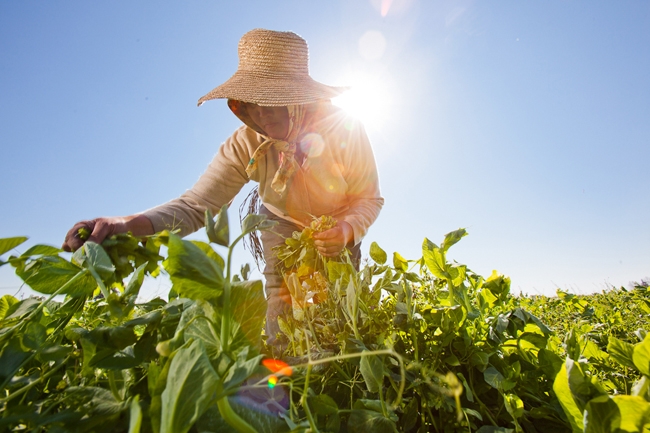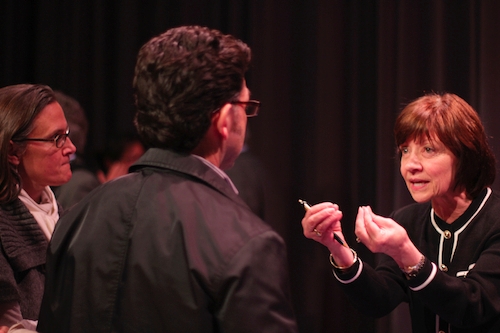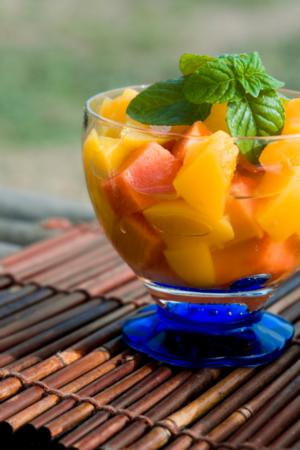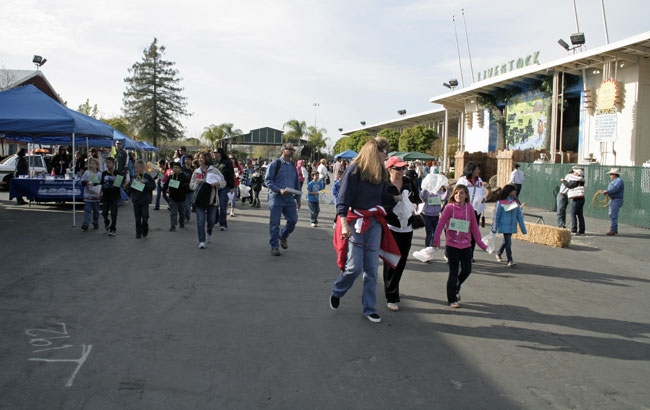Posts Tagged: nutrition
Cultivating California
Only in California could arid land be converted into the nation’s salad bowl.
In the late 1800s, University of California researchers discovered how to remove salts from the soils of the Central Valley, turning it into one of the most productive agricultural regions.
UC researchers continue to play a key role in agriculture today, keeping California the nation’s leading agricultural state, from dairies in Tulare to nut farms in Newberry Springs.
A new brochure highlights the breadth of UC Agriculture and Natural Resources’ impact. UC guidelines have helped farmers boost broccoli production. UC scientists have developed sweet-tasting citrus and strawberries to meet consumer demands. UC certifies more than 95 percent of wine grapevines grown in the state, providing a reliable supply of high-quality vines for California’s multibillion-dollar wine industry. Whether it’s managing invasive pests, promoting nutrition or sustaining small farmers, ANR serves California’s communities with a focus on advising, educating and searching for solutions.
For more information, read the Cultivating California brochure.

uc anr minibrochure cover s2
The U.S. Farm Bill: What's at stake?
The United States farm bill is up for renewal this year, and what goes into the $400 billion, 5,000-plus page piece of legislation will affect what tens of millions of Americans eat — and don’t eat — in the coming years. On April 5, UC Berkeley’s College of Natural Resources fired off an enlightening salvo in the public discourse, with a panel of heavy hitters calling on the public to let their voices be heard in the quest to, as panelist Karen Ross, Secretary of the California Department of Food and Agriculture, put it, “move farmers and eaters closer together.”
Looking at the bill’s history, it’s not surprising the two groups have been driven apart. The farm bill was implemented during the Great Depression in the 1930s in order to raise commodity prices and farmers’ incomes, said Gordon Rausser, UC Berkeley professor of agricultural and resource economics and the event’s moderator. The commodities it focused on — food grains, feed grains, dairy, tobacco and peanuts — became political powerhouses while much of the food on our dinner tables — fruits, vegetables, and nuts — were relegated to the category of “specialty crops.”
Broccoli and oranges … specialty crops? “That’s what we grow here in California,” Ross said. And that's what's on the U.S. Department of Agriculture’s food plate. In the past 15 years such growers have been taking a more active role in the farm bill to make sure they are not marginalized, she said.
Over eight decades the bill has morphed from a farm to a food bill, the panelists said. Seventy-seven percent of the bill now goes to support the federal Supplemental Nutritional Assistance Program (SNAP), the reinvention of the food stamps program.
Ken Hecht, just retired from his position as the director of the California Food Policy Advocates, reeled off some facts about the people who use SNAP:
- 50 percent are working households
- 93 percent are below the poverty level
- 50 percent of benefit recipients are children
- 75 percent are households with children
“There are 1.3 million children who are getting enough to eat because of this program,” Hecht said. “It avoids all those consequences of food insecurity that we all know about: lack of adequate nutrition, lack of adequate health, lack of academic opportunity and performance, lack of social development.” The program not only helps its participants, Hecht, said, but the rest of the people in the community as well.
In addition to SNAP, support for sustainable agriculture emerged as a theme of the presentation. For insight, In Defense of Food author and UC Berkeley journalism professor Michael Pollan offered the audience the perspective of a Martian: we Earthlings are now eating oil instead of eating sunlight. What he referred to as the “free lunch of photosynthesis” was swapped out, starting in the 1940s, for high-yield, industrialized farming that relies on pesticides, machines and giant feed-lots for animals. Pollan said that while farmers were enormously successful in achieving productivity goals, the environmental costs make agriculture second only to cars in fossil fuel production, and the producer of 20 to 30 percent of the country’s greenhouse gases. He recommends a simple criteria should be applied to every provision of the farm bill, from farmers market support to the SNAP program to obscure payment structures: “The question we should ask ourselves is, is this pushing agriculture back onto the sun or is it leaving it on the fossil fuel basis?” he said. “That’s the standard I think we need to apply.”
Ken Cook, president and co-founder of the Environmental Working Group, framed the issue in terms of dollars. “One cotton farmer in 2004 received $2 million. That’s the same amount of money we spent for the entire federal program devoted to organic agricultural research,” he said.
He emphasized the connection between good food practices and good environmental practices, and called SNAP EWG’s number one priority. “We’re trying to inject healthy eating into the farm bill as a legitimate concern of public policy,” he said. He cited a pilot healthy-snack program, in which evaluators noted students who had never seen a pineapple or celery or carrots before. “We should be spending billions of dollars on this program ... getting kids hooked on fruits and vegetables."
Cook pointed out that that much of what drives the farm bill is the politics of committee members securing subsidies for their home states, and conjured the specter of the recent pink-slime debacle to show how effective a little activism can be. Fail to get involved at your peril, Cook, said. “I guarantee you will get more of the same or worse.”
Pollan passed along advice from one of Cook’s staffers: “Simply calling your representative and saying you want more healthy food, you want more environmentally sustainable food, is all you need to do.”
The event was a presentation of the UC Berkeley College of Natural Resource's Spring 2012 Horace Albright Lecture in Conservation. Watch an hour and a half video of the presentations and Q&A:
Ode to Breakfast!
Breakfast has to be the greatest meal of the day by far! I might be biased because it includes coffee – in my opinion the greatest beverage in the world - but that’s a subject for another day.
There are so many benefits to breakfast. The options of what to eat are endless - plus breakfast wakes you up and gets you energized for your day! It makes me sad that most people won’t take the time to fall in love with breakfast.
The usual excuses are always present:
- “I’m on a diet, so I’m skipping breakfast!”
- “I don’t have time.”
- “I’ll grab something at insert fast food/coffee house chain here it’s easier.”
- “I can’t eat breakfast, it upsets my stomach.”
Come on people wake up and smell the oatmeal and eggs!
Breakfast can be the most elaborate meal to make OR the easiest and fastest. Here are some tips to help beat the excuses and rediscover breakfast for the health of you and your family!
Skipping a meal will help you lose weight—true or false? FALSE! Breakfast literally means to “break-the-fast,” after sleeping all night. It’s important to eat to get your metabolism going for the day! Watching your weight? Try taking the time to create these meals that contain all 5 MyPlate food groups:
- Make an omelet or scrambled eggs and toss in your f avorite chopped veggies. Cut the fat by using just the egg whites. Add some low-fat cheese, and eat with whole wheat toast and a sliced apple.
- Make your own power smoothie: blend an apple, banana, some berries, a carrot and zucchini with low-fat yogurt and some orange juice. Serve with half of a whole wheat bagel topped with peanut butter.
- Make a breakfast burrito! Warm a whole wheat tortilla, cook up your favorite meat, scrambled eggs, and toss in some black beans. Add veggies, salsa, and low-fat cheese.
Breakfast takes too long to make-true or false? FALSE! So you would rather sleep in an extra 15 minutes than take the time to make a hot breakfast?
DO get that beauty rest!
DON’T skip breakfast or spend the money on a less healthy fast food breakfast.
Try these tips to have a healthy breakfast on the go:
- Take a whole wheat tortilla and spread with peanut butter; add granola and your favorite fruit! Roll it up and go. Take a glass of low-fat milk with you to get some dairy.
- Broil half of a whole wheat bagel with low-fat cheese; eat on the go with a hardboiled egg, and a banana.
- Prep your breakfast burrito the night before, so it’s ready to grab on your way out the door.
Breakfast isn’t for everyone-true or false? FALSE! So you tend to have a bit of a queasy stomach in the morning? Here are some tips to overcome the queasy and still eat breakfast:
- Take your time, don’t rush to eat breakfast. Set aside time to relax and enjoy your meal.
- Take your food with you to work or school, wait until your stomach calms down and then eat!
- Queasiness tends to be the effect of an empty stomach, so it’s even more important to eat breakfast.
When you eat a healthy breakfast you are more likely to focus and pay better attention to work, school or home activities.
Getting kids excited about 'anytime' foods
Children can eat a healthier diet by making some easy substitutions in their food choices, avoiding "sometimes food," like candy, soda and chips, and instead eating "anytime food," like fruits, vegetables and low-fat milk.
UC Cooperative Extension nutrition educators in Fresno County staged a skit at the Fresno County Food & Nutrition Day March 23 to reinforce these healthy eating messages. The event drew nearly 2,000 third-graders to the fairgrounds.
"Scarlet Strong," played by UCCE nutrition educator Nath Say, battled it out with "Rhonda Rotten Tooth," brought to life by UCCE nutrition educator Shawna Rogers.
Applause by the children gave Scarlet strength to knock down the unhealthful food Rhonda prefers - crunchy cheese sticks, chocolate chip cookies, candy, french fries and sugary soda - and encourage Scarlet to instead choose carrots, strawberries, bananas, sesame seed pretzels and milk.
The skit complements UCCE's CalFresh nutrition education program, which reaches out to children in schools where 50 percent or more of the students are eligible to receive free or reduced-price lunches.
Watch the skit in the three-minute video below:
Healthy snacks, healthy communities
A Food Blog post last week highlighted the great work of UC CalFresh, the UC Cooperative Extension nutrition education program that reaches more than 220,000 people a year, helping low-income families make healthy food choices, stretch food dollars and increase consumption of California’s agricultural products.
The University of California has an array of healthy living outreach efforts. In addition to CalFresh, one program that you might not expect involves the UC Davis School of Medicine. The Communities and Health Professionals Together program links pediatric residents with community-based organizations to identify and address health concerns.
Residents are assigned in teams to work with a grassroots, community-based organization, under the direction of a local leader or faculty member. Residents learn to identify and mobilize community assets to create, implement and evaluate projects that enhance the health and well being of local children and families. The program helps train physicians to be dedicated to their patients and their communities.
Resident Andrew Nuibe helps kids in a K-6 afterschool homework club prepare their own healthy snacks — and prevent childhood obesity.
“I encounter childhood obesity too often in my clinic, and that served as my inspiration,” Nuibe said. “As a child, I really enjoyed cooking with my parents. I wanted to share that enthusiasm and plant the seeds for a genuine interest in healthy food.”

UC Davis medical resident Andrew Nuibe helps kids in an afterschool club prepare healthy snacks.







